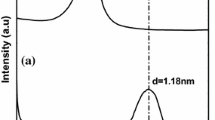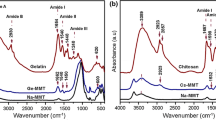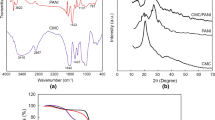Abstract
Herein, we have reported the exfoliation of laponite (L) in the presence of carboxymethyl cellulose (CMC) and the formation of CMC–laponite (CMC–L) nanocomposite gel. Analysis of CMC–L complex using XRD confirmed that the addition of CMC actually exfoliates laponites. The interplanar spacing of laponite was observed to increase from 0.74 to 0.98 nm when concentration of CMC, CCMC, increased from 0 to 0.5% w/v in aqueous solution of laponite having concentration of laponite, CL = 1% w/v. Time-dependent scattering intensity studied by dynamic light scattering on CMC–L complex (CCMC = 0.5% w/v, CL = 1% w/v) in aqueous medium illustrated that the exfoliation progresses with the passage of time. It was further observed that the CMC–L complex (CL = 1% w/v, CCMC ≥ 0.5% w/v) forms gel, and the strength of gel increases with the increase in CMC concentration in aqueous medium owing to interaction between exfoliated laponite and CMC. Furthermore, microstructure of the gels and their mesh size were studied using small-angle neutron scattering (SANS). SANS study revealed the fact that with the increase in CCMC from 0.5 to 2% w/v in CMC–L gels, mesh size, ξ decreases from 0.29 to 0.24 nm. This decrease in mesh size is responsible for sustained drug release of methylene blue which was chosen as a cationic model drug. The obtained drug release profile was fitted with different release kinetic models, and it was found that release profile follow first-order kinetic model.













Similar content being viewed by others
References
Lorthioir C, Khalil M, Wintgens V, Amiel C (2012) Segmental motions of poly(ethylene glycol) chains adsorbed on laponite platelets in clay-based hydrogels: a NMR investigation. Langmuir 28:7859–7871. https://doi.org/10.1021/la3010757
Mauroy H, Rozynek Z, Plivelic TS et al (2013) Oxygen-controlled phase segregation in poly(N-isopropylacrylamide)/laponite nanocomposite hydrogels. Langmuir 29:371–379. https://doi.org/10.1021/la303889s
Sun K, Raghavan SR (2010) Thermogelling aqueous fluids containing low concentrations of pluronic F127 and laponite nanoparticles. Langmuir 26:8015–8020. https://doi.org/10.1021/la904907b
Xu D, Hodges C, Ding Y et al (2010) A QCM study on the adsorption of colloidal laponite at the solid/liquid interface. Langmuir 26:8366–8372. https://doi.org/10.1021/la904784a
Yang Y, Liu Z, Wu D et al (2013) Edge-modified amphiphilic laponite nano-discs for stabilizing pickering emulsions. J Colloid Interface Sci 410:27–32. https://doi.org/10.1016/j.jcis.2013.07.060
Wang S, Wu Y, Guo R et al (2013) Laponite nanodisks as an efficient platform for doxorubicin delivery to cancer cells. Langmuir 29:5030–5036. https://doi.org/10.1021/la4001363
Wang X, Sun P, Xue G, Winter HH (2010) Late-state ripening dynamics of a polymer/clay nanocomposite. Macromolecules 43:1901–1906. https://doi.org/10.1021/ma901665m
Nie X, Adalati A, Du J et al (2014) Preparation of amphoteric nanocomposite hydrogels based on exfoliation of montmorillonite via in-situ intercalative polymerization of hydrophilic cationic and anionic monomers. Appl Clay Sci 97–98:132–137. https://doi.org/10.1016/j.clay.2014.05.020
Sharma A, Rawat K, Solanki PR, Bohidar HB (2017) Surface patch binding-induced exfoliation of nanoclays and enhancement of physical properties of gelatin organogels: Surface patch binding-induced exfoliation of nanoclays. Polym Int 66:327–336. https://doi.org/10.1002/pi.5281
Nicolai T, Cocard S (2000) Light scattering study of the dispersion of laponite. Langmuir 16:8189–8193. https://doi.org/10.1021/la9915623
Takahashi N, Hata H, Kuroda K (2011) Exfoliation of layered silicates through immobilization of imidazolium groups. Chem Mater 23:266–273. https://doi.org/10.1021/cm102942s
Ali S, Bandyopadhyay R (2015) Evaluation of the exfoliation and stability of Na-montmorillonite in aqueous dispersions. Appl Clay Sci 114:85–92. https://doi.org/10.1016/j.clay.2015.05.013
Karpovich A, Vlasova M, Sapronova N et al (2016) Exfoliation dynamics of laponite clay in aqueous suspensions studied by NMR relaxometry. Orient J Chem 32:1679–1683. https://doi.org/10.13005/ojc/320346
Wu W, Dong Z, He J et al (2016) Transparent cellulose/laponite nanocomposite films. J Mater Sci 51:4125–4133. https://doi.org/10.1007/s10853-016-9735-8
Gabr MH, Phong NT, Abdelkareem MA et al (2013) Mechanical, thermal, and moisture absorption properties of nano-clay reinforced nano-cellulose biocomposites. Cellulose 20:819–826. https://doi.org/10.1007/s10570-013-9876-8
Chang C-W, van Spreeuwel A, Zhang C, Varghese S (2010) PEG/clay nanocomposite hydrogel: a mechanically robust tissue engineering scaffold. Soft Matter 6:5157. https://doi.org/10.1039/c0sm00067a
Boyer C, Figueiredo L, Pace R et al (2018) Laponite nanoparticle-associated silated hydroxypropylmethyl cellulose as an injectable reinforced interpenetrating network hydrogel for cartilage tissue engineering. Acta Biomater 65:112–122. https://doi.org/10.1016/j.actbio.2017.11.027
Lewis G (2017) Properties of nanofiller-loaded poly (methyl methacrylate) bone cement composites for orthopedic applications: a review: properties of nanofiller-loaded bone cements. J Biomed Mater Res B Appl Biomater 105:1260–1284. https://doi.org/10.1002/jbm.b.33643
Golafshan N, Rezahasani R, Tarkesh Esfahani M et al (2017) Nanohybrid hydrogels of laponite: PVA-alginate as a potential wound healing material. Carbohydr Polym 176:392–401. https://doi.org/10.1016/j.carbpol.2017.08.070
Gonçalves M, Figueira P, Maciel D et al (2014) pH-sensitive laponite®/doxorubicin/alginate nanohybrids with improved anticancer efficacy. Acta Biomater 10:300–307. https://doi.org/10.1016/j.actbio.2013.09.013
Cerisuelo JP, Gavara R, Hernández-Muñoz P (2015) Diffusion modeling in polymer–clay nanocomposites for food packaging applications through finite element analysis of TEM images. J Membr Sci 482:92–102. https://doi.org/10.1016/j.memsci.2015.02.031
Bortolin A, Aouada FA, Mattoso LHC, Ribeiro C (2013) Nanocomposite PAAm/methyl cellulose/montmorillonite hydrogel: evidence of synergistic effects for the slow release of fertilizers. J Agric Food Chem 61:7431–7439. https://doi.org/10.1021/jf401273n
Ramos AM, Pereira S, Cidade MT et al (2013) Preparation and characterization of cellulose nanocomposite hydrogels as functional electrolytes. Solid State Ion 242:26–32. https://doi.org/10.1016/j.ssi.2013.03.028
Yao K, Huang S, Tang H et al (2017) Bioinspired interface engineering for moisture resistance in nacre-mimetic cellulose nanofibrils/clay nanocomposites. ACS Appl Mater Interfaces 9:20169–20178. https://doi.org/10.1021/acsami.7b02177
Gul S, Kausar A, Muhammad B, Jabeen S (2016) Research progress on properties and applications of polymer/clay nanocomposite. Polym Plast Technol Eng 55:684–703. https://doi.org/10.1080/03602559.2015.1098699
Luo J (2003) Characterization and modeling of mechanical behavior of polymer/clay nanocomposites. Compos Sci Technol 63:1607–1616. https://doi.org/10.1016/S0266-3538(03)00060-5
de Oliveira RL, da Barud HS, De Salvi DTB et al (2015) Transparent organic–inorganic nanocomposites membranes based on carboxymethylcellulose and synthetic clay. Ind Crops Prod 69:415–423. https://doi.org/10.1016/j.indcrop.2015.02.015
Farhadnejad H, Mortazavi SA, Erfan M et al (2018) Facile preparation and characterization of pH sensitive Mt/CMC nanocomposite hydrogel beads for propranolol controlled release. Int J Biol Macromol 111:696–705. https://doi.org/10.1016/j.ijbiomac.2018.01.061
Perotti GF, Barud HS, Messaddeq Y et al (2011) Bacterial cellulose–laponite clay nanocomposites. Polymer 52:157–163. https://doi.org/10.1016/j.polymer.2010.10.062
Yuan Z, Fan Q, Dai X et al (2014) Cross-linkage effect of cellulose/laponite hybrids in aqueous dispersions and solid films. Carbohydr Polym 102:431–437. https://doi.org/10.1016/j.carbpol.2013.11.051
Yang Q, Wu C-N, Saito T, Isogai A (2014) Cellulose–clay layered nanocomposite films fabricated from aqueous cellulose/LiOH/urea solution. Carbohydr Polym 100:179–184. https://doi.org/10.1016/j.carbpol.2012.10.044
Bounabi L, Mokhnachi NB, Haddadine N et al (2016) Development of poly(2-hydroxyethyl methacrylate)/clay composites as drug delivery systems of paracetamol. J Drug Deliv Sci Technol 33:58–65. https://doi.org/10.1016/j.jddst.2016.03.010
Hernández D, Lazo L, Valdés L et al (2018) Synthetic clay mineral as nanocarrier of sulfamethoxazole and trimethoprim. Appl Clay Sci 161:395–403. https://doi.org/10.1016/j.clay.2018.03.016
Winter HH, Chambon F (1986) Analysis of linear viscoelasticity of a crosslinking polymer at the gel point. J Rheol 30:367–382. https://doi.org/10.1122/1.549853
Barnes HA (2000) A handbook of elementary rheology. University of Wales, Wales
Arfin N, Bohidar HB (2014) Ergodic-to-nonergodic phase inversion and reentrant ergodicity transition in DNA–nanoclay dispersions. Soft Matter 10:149–156. https://doi.org/10.1039/C3SM52218K
Arfin N, Aswal VK, Bohidar HB (2014) Overcharging, thermal, viscoelastic and hydration properties of DNA–gelatin complex coacervates: pharmaceutical and food industries. RSC Adv 4:11705–11713. https://doi.org/10.1039/C3RA46618C
Arfin N, Aswal VK, Kohlbrecher J, Bohidar HB (2015) Relaxation dynamics and structural changes in DNA soft gels. Polymer 65:175–182. https://doi.org/10.1016/j.polymer.2015.03.073
Papagiannopoulos A, Zhao J, Zhang G et al (2014) Thermoresponsive aggregation of PS–PNIPAM–PS triblock copolymer: a combined study of light scattering and small angle neutron scattering. Eur Polym J 56:59–68. https://doi.org/10.1016/j.eurpolymj.2014.04.013
Li Y, Maciel D, Tomás H et al (2011) pH sensitive laponite/alginate hybrid hydrogels: swelling behaviour and release mechanism. Soft Matter 7:6231. https://doi.org/10.1039/c1sm05345k
Tsai F-H, Chiang P-Y, Kitamura Y et al (2017) Producing liquid-core hydrogel beads by reverse spherification: effect of secondary gelation on physical properties and release characteristics. Food Hydrocoll 62:140–148. https://doi.org/10.1016/j.foodhyd.2016.07.002
Eswaramma S, Reddy NS, Rao KSVK (2017) Phosphate crosslinked pectin based dual responsive hydrogel networks and nanocomposites: development, swelling dynamics and drug release characteristics. Int J Biol Macromol 103:1162–1172. https://doi.org/10.1016/j.ijbiomac.2017.05.160
Wang W, Hui PCL, Wat E et al (2016) In vitro drug release and percutaneous behavior of poloxamer-based hydrogel formulation containing traditional Chinese medicine. Colloids Surf B Biointerfaces 148:526–532. https://doi.org/10.1016/j.colsurfb.2016.09.036
Rassu G, Salis A, Porcu EP et al (2016) Composite chitosan/alginate hydrogel for controlled release of deferoxamine: a system to potentially treat iron dysregulation diseases. Carbohydr Polym 136:1338–1347. https://doi.org/10.1016/j.carbpol.2015.10.048
Dash S, Murthy PN, Nath L, Chowdhury P (2010) Kinetic modeling on drug release from controlled drug delivery systems. Acta Pol Pharm 67:217–223
Jung H, Kim H-M, Choy YB et al (2008) Itraconazole–laponite: kinetics and mechanism of drug release. Appl Clay Sci 40:99–107. https://doi.org/10.1016/j.clay.2007.09.002
Joshi GV, Pawar RR, Kevadiya BD et al (2011) Mesoporous synthetic hectorites: a versatile layered host with drug delivery application. Microporous Mesoporous Mater 142:542–548. https://doi.org/10.1016/j.micromeso.2010.12.040
Acknowledgements
Authors are thankful to UGC start-up Grant (F.30-359/2017(BSR)) for the funding. Authors are also thankful to the Central Instrumentation Facility, Jamia Millia Islamia and Centre for Nanoscience and Nanotechnology, Jamia Millia Islamia for the instrumentation facility.
Author information
Authors and Affiliations
Corresponding author
Additional information
Publisher's Note
Springer Nature remains neutral with regard to jurisdictional claims in published maps and institutional affiliations.
Rights and permissions
About this article
Cite this article
Tiwari, P., Ranjan, R., Das, K. et al. Exfoliation and gelation in laponite–carboxymethyl cellulose complexes and its application in sustained drug release. Polym. Bull. 77, 5389–5406 (2020). https://doi.org/10.1007/s00289-019-03019-z
Received:
Revised:
Accepted:
Published:
Issue Date:
DOI: https://doi.org/10.1007/s00289-019-03019-z




